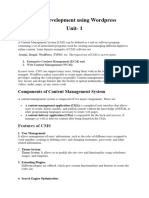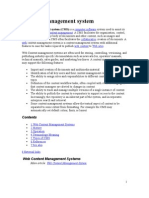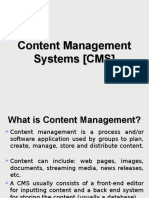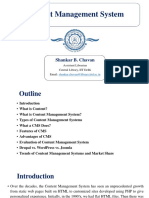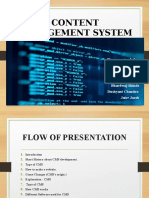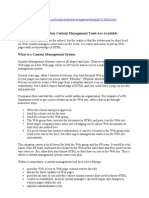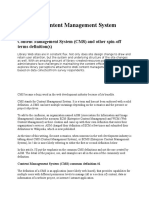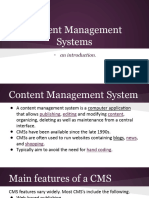CMS PDF
Uploaded by
Deepak RastogiCMS PDF
Uploaded by
Deepak RastogiKM
COLUMN
JUNE 2003
So, what is a content management
system?
A content management system (CMS) is crit- CMS: A working definition
ical to the success of almost every website
A content management system (CMS) sup-
and intranet, and yet many organisations are
ports the creation, management, distribu-
not familiar with this technology.
tion, publishing, and discovery of corporate
So, while we have written many articles on information.
a range of specific CMS issues and strategies,
It covers the complete lifecycle of the pages
we now take a step back to answer the ques-
on your site, from providing simple tools to
tion: what is a content management system?
create the content, through to publishing,
In this article we will focus on web content and finally to archiving.
management, and will only touch upon
It also provides the ability to manage the
broader content issues at the end of the doc-
structure of the site, the appearance of the
ument.
published pages, and the navigation provid-
ed to the users.
The business problem
Note that we are focusing on the most com-
You have a website, or intranet. It has grown mon use of a CMS: to manage web content.
organically over time, and while it is very In some circles, these systems are therefore
useful, it is far from perfect. called web management systems (WMS).
Much of the content is out-of-date or inaccu- Content management systems can be much
rate, its hard to find things, updating the site broader than this, but we wont touch upon
is complex, and the appearance is becoming these aspects until later.
dated.
Worse yet, youve lost track of all the pages Business benefits
on the site, and by having all the changes There are a wide range of business benefits
made by your skilled webmaster, the up- that can be obtained by implementing a
dates are piling up in their in-tray. CMS, including:
What was on the site last week, or last year? streamlined authoring process
You couldnt say. In the back of your mind,
you know that this could leave you in a dif- faster turnaround time for new pages and
ficult position if a customer sues, but there is changes
little that you can do. greater consistency
If this sounds grim, you are not alone. In improved site navigation
fact, its the natural by-product of maintain-
increased site flexibility
ing a site using manual tools such as
Dreamweaver or Frontpage. support for decentralised authoring
Thankfully, these problems are what a con- increased security
tent management system is specifically de- reduced duplication of information
signed to solve.
greater capacity for growth
reduced site maintenance costs
About the author Beyond these, the greatest benefit the CMS
James Robertson is the managing director of Step Two De- can provide is to support your business goals
signs, a knowledge management and content manage- and strategies.
ment consultancy based in Australia. James specialises in
intranets, content management strategy, information ar- For example, the CMS can help to improve
chitecture and usability. sales, increase user satisfaction, or assist in
communicating with the public.
Copyright 2005, Step Two Designs Pty Ltd www.steptwo.com.au
knowledge management content management intranets usability information architecture
Publishing
Content Content Presentation
Creation Management
Anatomy of a CMS maintains the press release section, while
your product manager keeps the catalogue
The functionality of a content management
up to date.
system can be broken down into several
main categories: Content management
content creation Once a page has been created, it is saved into
content management a central repository in the CMS. This stores
all the content of the site, along with the oth-
publishing
er supporting details.
presentation
This central repository allows a range of use-
Each of these will be explored in the follow- ful features to be provided by the CMS:
ing sections.
Keeping track of all the versions of a
page, and who changed what and when.
Ensuring that each user can only change
The CMS manages the entire the section of the site they are
responsible for.
lifecycle of pages, from
Integration with existing information
creation to archival sources and IT systems.
Most importantly, the CMS provides a range
of workflow capabilities. These are best ex-
Content creation
plained by giving an example:
At the front of a content management system
When the page is created by an author, it is
is an easy-to-use authoring environment, de-
automatically sent to their manager for ap-
signed to work like Word. This provides a
proval, and then to the central web team for
non-technical way of creating new pages or
their editorial review. It is finally sent to the
updating content, without having to know
legal team for their sign-off, before being au-
any HTML.
tomatically published to the site.
The CMS also allows you to manage the
At each step, the CMS manages the status of
structure of the site. That is, where the pages
the page, notifying the people involved, and
go, and how they are linked together. Many
escalating jobs where required.
even offer simple drag-and-drop restructur-
ing of the site, without breaking any links. In this way, the workflow capabilities allow
more authors to be involved in the manage-
Almost all content management systems
ment of the site, while maintaining strict
now provide a web-based authoring envi-
control over the quality, accuracy and con-
ronment, which further simplifies imple-
sistency of the information.
mentation, and allows content updating to
be done remotely.
It is this authoring tool that is the key to the Workflow rules bring order to
success of the CMS. By providing a simple
mechanism for maintaining the site, author- the chaos of manual processes
ing can be devolved out into the business it-
self. For example, your marketing manager
So, what is a content management system? Page 2
Copyright 2005, Step Two Designs Pty Ltd www.steptwo.com.au
Publishing Enterprise content management
Once the final content is in the repository, it There is also a relationship between content
can then be published out to either the web- management systems and other information
site or intranet. systems within an organisation, including:
Content management systems boast power- document management
ful publishing engines which allow the ap-
pearance and page layout of the site to be records management
applied automatically during publishing. It digital asset management
may also allow the same content to be pub-
lished to multiple sites. At present, these are typically sold as sepa-
rate systems, and achieving interoperability
Of course, every site looks different, so the
between them is not easy.
CMS lets the graphic designers and web de-
velopers specify the appearance that is ap- Some progress is being made with the crea-
plied by the system. tion of so-called enterprise content manage-
ment systems (ECMS), which combine
These publishing capabilities ensure that
together a central content management sys-
the pages are consistent across the entire
tem with other tools to manage the full range
site, and enable a very high standard of ap-
of content that exists within your organisa-
pearance.
tion.
This also allows the authors to concentrate
on writing the content, by leaving the look of These systems are relatively immature, how-
the site entirely to the CMS. ever, and there is not much agreement about
what they should encompass. This is cer-
tainly a market that will evolve rapidly over
the next few years.
The CMS fully automates the
publishing of your site Take the time to pick the best
product to meet your needs
Presentation
The content management system can also
provide a number of features to enhance the CMS marketplace
quality and effectiveness of the site itself. This article has presented a general over-
As an example, the CMS will build the site view of typical content management system
navigation for you, by reading the structure capabilities, and how they can be used to
straight out of the content repository. benefit your business.
It also makes it easy to support multiple In the marketplace at present, there are liter-
browsers, or users with accessibility issues. ally hundreds of content management sys-
The CMS can be used to make your site dy- tems, all having different capabilities and
namic and interactive, thereby enhancing strengths.
the sites impact.
This is the nature of a rapidly changing mar-
ketplace: while there are many very good
Beyond the web products, there is little consistency between
So far, we have concentrated on the creation vendors.
of HTML content for corporate websites or Our single best piece of advice: take the time
intranets. While this is the strongest aspect to determine your business requirements,
of most content management systems, many and then comprehensively evaluate the
can do much more. products on the market against them.
Central to the power of many systems is the Every organisation has a unique set of re-
concept of single source publishing, where quirements for a content management sys-
a single topic can be published automatical- tem, and there is no one-size-fits-all
ly into different formats. solution. By allocating sufficient time and
This could include printed formats (PDF, resources to selecting the CMS, you can be
Word, etc), wireless/hand-held formats confident that you have the best possible so-
(WAP, etc), or XML. lution.
So, what is a content management system? Page 3
Copyright 2005, Step Two Designs Pty Ltd www.steptwo.com.au
Conclusion Other articles of interest
Content management systems are relatively Centralised or decentralised authoring?
new in the market, and while many are still Losing sight of the content in a CMS
not familiar with them, they have the poten-
tial to dramatically simplify the mainte- What are the goals of a CMS?
nance of both websites and intranets. Why every small website needs a CMS
This article has given a high-level overview Putting metadata to work
of CMS capabilities. For more information Metrics for content management &
on specific CMS issues or aspects, browse knowledge management
through the other articles available on our
website (www.steptwo.com.au). Is it document management or content
management?
For example, you will probably find our arti-
A CM project presents unique challenges
cle How to evaluate a CMS to be very useful
when investigating specific products on the
market.
More articles! Did you like this article?
Find out when new papers are published: Send your thoughts and feedback to:
www.steptwo.com.au/papers/subscribe jamesr@steptwo.com.au
Step Two DESIGNS
www.steptwo.com.au contact@steptwo.com.au
knowledge management content management intranets
So, what is a content management system? Page 4
Copyright 2005, Step Two Designs Pty Ltd www.steptwo.com.au
Content Management
Requirements Toolkit
Fully-revised, and almost twice the size, the new
version of the Content Management Requirements
Toolkit captures the latest thinking in the content
management industry. In addition to the expanded
range of requirements, the Toolkit now provides a
comprehensive guide to writing CMS scenarios, as
well as a detailed overview of the whole selection
process.
Choosing a content management system (CMS) is not
easy. There are hundreds of products in the
marketplace, all with highly-variable capabilities. In
this rapidly-evolving environment, the challenge is to
find the CMS that best matches your business needs.
The Content Management Requirements Toolkit
provides a comprehensive starting point for identifying
the business and technical requirements that will drive
your selection process.
It contains 133 fully-developed requirements, across
five main categories.
n content creation
n content management
The single best n publishing
resource for rapidly n presentation
n contract & business
creating an effective
These ready to use requirements can be cut-and-
tender and selecting pasted directly into your tender document. This will
the right CMS. save you days of work, and is an invaluable checklist to
ensure that no critical requirements are missed.
Clear and concise, these requirements have been
distilled from real-world experience, and reflect actual
business needs.
Version 2.0
Fully-downloadable package
123 pages, August 2004
US$ 550.00
Step Two
DESIGNS CMSLIFECYCLE
For more information on the Requirements Toolkit,
sample pages, and secure online ordering, visit:
Produced and published by Step Two Designs www.steptwo.com.au
You might also like
- Column: So, What Is A Content Management System?No ratings yetColumn: So, What Is A Content Management System?5 pages
- Content Management System: Quality Standards Citations VerificationNo ratings yetContent Management System: Quality Standards Citations Verification2 pages
- Week 9 - Module 22 - PPT - Content Management SystemNo ratings yetWeek 9 - Module 22 - PPT - Content Management System38 pages
- What Is A Content Management System Definition From TechTargetNo ratings yetWhat Is A Content Management System Definition From TechTarget1 page
- Content Management System: Presented byNo ratings yetContent Management System: Presented by29 pages
- Title: Web Content Management System Year: 2011-2012 Group Id: 6 Project DescriptionNo ratings yetTitle: Web Content Management System Year: 2011-2012 Group Id: 6 Project Description9 pages
- Brief Description About Content Management SystemNo ratings yetBrief Description About Content Management System7 pages
- Advanced Website Development & Management: What Is CMS?No ratings yetAdvanced Website Development & Management: What Is CMS?7 pages
- 02 CH 1 - Introduction To Content Management PDFNo ratings yet02 CH 1 - Introduction To Content Management PDF29 pages
- Content Management System For Web PortalNo ratings yetContent Management System For Web Portal4 pages
- "Joomla" A Web Content Management System "Joomla" A Web Content Management SystemNo ratings yet"Joomla" A Web Content Management System "Joomla" A Web Content Management System9 pages

